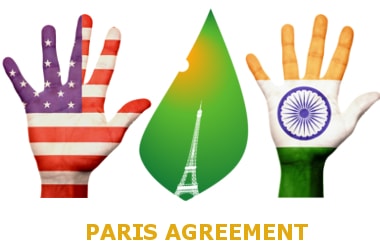
Developed Vs Developing World & The Paris Deal
The Paris Agreement addresses numerous aspects of climate change from mitigation to adaptation, financing to green diplomacy. But the divide between developed nations like the US and developing nations like India need the skills to deal with the most critical challenges of our times.
About the Paris Agreement- The Paris Agreement on climate change was finalised at the 21st Conference of the Parties (COP) of the United Nations Framework Convention on Climate Change (UNFCCC), held in Paris in December 2015.
- A welcome sign of a collective resolve for climate change, it now carries the stamp of disappointment among developing countries which will bear the brunt of the adverse climate change.
- Parties acquiesced under article 2.1 (a) of the Agreement to keep global temperature increase well below 2°C and to pursue efforts to limit it to 1.5°C.
- A global goal on climate adaptation serves as an important tool for facilitating the tenets of the agreement
Developing Countries: A Formidable Challenge 1. Poverty the main focus The main challenge for developing nations is to address poverty and underdevelopment. Climate change makes this a formidable proposition. Limited and fragile productive capacities have been tested to their maximum stretching point.
2. Need for adequate mitigation targets Adequate mitigation targets need to be based on respective historic responsibilities and capacities of countries. Adaptation efforts at the same level as mitigation targets provides sufficient provision for financing and technology transfer to assist in making the transition to greener economies. The Paris Agreement succeeds in addressing these elements to only some extent.
3. Leadership Issues INDCs current pledges hold that not even a target of 2 degree C will be delivered and the agreement noted “estimated aggregate greenhouse gas emission levels in 2025 and 2030 resulting from the INDCs do not fall within least-cost 2 degrees Celsius scenarios but rather lead to a projected level of 55 giga tonnes in 2030”.
4. Trade and response measures The trade-climate change nexus may become even more challenging after the Paris Agreement. Measures and actions being developed and to be developed by countries, particularly developed countries may have trade consequences for developing countries particularly in Africa. Lack of convergence in these response measures makes a difference to the culmination of this deal. A greater attention needs to be paid to the relationship of trade and climate change and examining the relevant trade rules to better address this relationship so that the outcome leads to a win-win situation.
5. Engagement of Stakeholders Parties to the Convention must meet their commitments as pledged in their INDCs so as to achieve the desired goal of the Paris Agreement.
The Developed World: Ignorance is Bliss? 1. Failure to honour pledges Developed countries have failed to provide financial resources and making green technology transfer to developing countries to ensure efficient implementation of the Agreement. There should not be any attempt to meet these commitments in ‘innovative’ ways that meet only the letter of the commitments while ignoring the spirit and intent.
2. A Paper Tiger? For developed countries, the Paris Agreement is a ‘paper tiger’ and not the game-changer that it can be. Climate action is needed even as the gap between developed and developing countries increases. Individuals need to be held accountable, but here even governments are not acquiescing.
3. Reneging on their Contracts? During the period of COP21, US and other nations announced increased commitment to provide financial support, in addition to the 11 developed countries' commitment to contributing 284 million dollars to the Least Developed Countries Fund (LDCF), aiming to help the most vulnerable countries in their adaptation sector. With developed countries launching their initiatives and issuing aggressive statements on climate change prior to the signature ceremony, it appeared that the future of low carbon emissions or even zero emissions may be achievable. This has now changed
Environment or Finance? Concluding Thoughts on Climate Change Action The biggest question that arose straining US and India ties was the role of environment and finance. While India held that it was working for mitigating and combating climate change, the US alleged our country was hungry for dollar money. The US must note that it did not even bother to uphold its commitments, and this vicious mud-slinging is detracting from the grave threat to our environment and our world. India reserves the right to hold developed nations like the US responsible for not fulfilling their pledges. Given the serious threat of climate change, it would be a befitting reply to questionable doubts and grave misconduct of the US government.